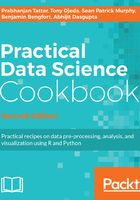
There's more...
We will discuss the various packages in greater detail in the chapter in which they are introduced. However, we would be remiss if we did not at least mention the Python IDEs. In general, we recommend using your favorite programming text editor in place of a full-blown Python IDE. This can include the open source Atom from GitHub, the excellent Sublime Text editor, or TextMate, a favorite of the Ruby crowd. Vim and Emacs are both excellent choices not only because of their incredible power but also because they can easily be used to edit files on a remote server, a common task for the data scientist. Each of these editors is highly configurable with plugins that can handle code completion, highlighting, linting, and more. If you must have an IDE, take a look at PyCharm (the community edition is free) from the IDE wizards at JetBrains, Spyder, and Ninja-IDE. You will find that most Python IDEs are better suited for web development as opposed to data work.